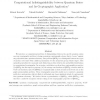Free Online Productivity Tools
i2Speak
i2Symbol
i2OCR
iTex2Img
iWeb2Print
iWeb2Shot
i2Type
iPdf2Split
iPdf2Merge
i2Bopomofo
i2Arabic
i2Style
i2Image
i2PDF
iLatex2Rtf
Sci2ools
EUROCRYPT
2005
Springer
2005
Springer
Computational Indistinguishability Between Quantum States and Its Cryptographic Application
We introduce a computational problem of distinguishing between two specific quantum states as a new cryptographic problem to design a quantum cryptographic scheme that is “secure” against any polynomial-time quantum adversary. Our problem QSCDff is to distinguish between two types of random coset states with a hidden permutation over the symmetric group of finite degree. This naturally generalizes the commonly-used distinction problem between two probability distributions in computational cryptography. As our major contribution, we show three cryptographic properties: (i) QSCDff has the trapdoor property; (ii) the average-case hardness of QSCDff coincides with its worst-case hardness; and (iii) QSCDff is computationally at least as hard in the worst case as the graph automorphism problem. These cryptographic properties enable us to construct a quantum public-key cryptosystem, which is likely to withstand any chosen plaintext attack of a polynomialtime quantum adversary. We f...
Cryptographic Properties | Cryptography | EUROCRYPT 2005 | Quantum Adversary | Quantum Cryptographic Scheme |
| Added | 27 Jun 2010 |
| Updated | 27 Jun 2010 |
| Type | Conference |
| Year | 2005 |
| Where | EUROCRYPT |
| Authors | Akinori Kawachi, Takeshi Koshiba, Harumichi Nishimura, Tomoyuki Yamakami |
Comments (0)

